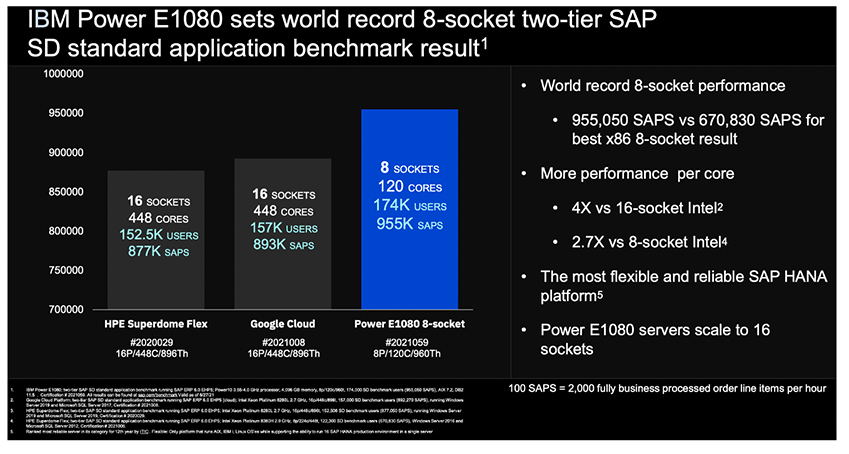Ron Gordon
Director, IBM Power Systems
A brief history of SAP: Systems, Applications, and Products (which is shortened to just SAP today) is a group of applications that support essential business functions such as ERP, CRM, PLM, finance, inventory, analytics, etc. SAP was first developed in 1972 in Germany by a company that was initially called System Analysis Program Development (Systemanalyse Programmentwicklung) and later was renamed simply SAP. There were many SAP releases with names like R/1, R/2, R/3, and SAP ECC (which stands for SAP ERP Central Component). To support the SAP environment, SAP would allow customers to use their database of choice, including DB2, Oracle, Sybase IQ, MaxDB, and Microsoft SQL Server. In 2011, SAP introduced SAP HANA, which originally stood for High-speed ANalytical Appliance, an in-memory database that replaced the “database of customer choice” with a single database whose goal was to operate with a near-zero response time for transactional and analytical data processing. Today the SAP ECC environment will reach end of support by SAP in 2027, and customers will have to move to the SAP HANA database and the SAP HANA supported application suites, such as S/4HANA, C/4HANA, BW4/HANA etc. While many SAP ECC customers have already moved to SAP HANA, those remaining have 5 years to plan and migrate to SAP HANA.
SAP on IBM Power Systems: SAP is considered a mission-critical application to customers who run all aspects of their enterprise on the SAP software. In today’s marketplace, customers who need high capacity, high performance, and high availability and reliability to support and optimize their SAP support infrastructure have been turning to IBM Power Systems to match their requirements so they can keep their business running efficiently and at the lowest cost/value. Today there are over 3500 customers running SAP on Power Systems supported by both scale-out and scale-up implementations based on POWER8, POWER9, and recently certified POWER10 technology, all supported with the leadership virtualization of PowerVM and a range of Linux options from SUSE and RedHat.
Power Systems and SAP HANA Continued Functional Growth: The journey of SAP HANA on Power Systems started with SAP HANA 1.0, which was then enabled on Linux only and was written to Big-Endian. Starting with SAP HANA 2.0 in 2017, Power Systems and SAP HANA moved to the Little-Endian format with specific Linux support versions from SUSE SLES for SAP Applications and RedHat RHEL for SAP Solutions. SAP HANA on Power Systems immediately became the platform of choice by providing the highest levels of support for customers needing scale-up solutions, with the highest level of performance, and by allowing running on a single server up to 4 production HANA DB environments and live movement between servers. This has progressed to 8 virtual HANA DBs and now is at 16 virtualized HANA DBs on a single server and still supports live movement between servers. Power Systems and SAP HANA in memory database sizes also have grown over time, supporting first 24 TB then 28 TB and now 32 TB memory sizes. While nonproduction workloads were always allowed to utilize all the PowerVM functionality, since performance was not critical, in 2019 PowerVM Shared processor pools were certified for production and PowerVM also introduced Persistent Memory, aka vPMem, where the HANA in-memory DB could be persistent between SAP HANA restarts. This function allowed SAP HANA upgrades to be performed rapidly because the HANA DB reload from persistent storage was eliminated and could save up to 8 hours of reload time.
2021 and 2022 latest Power System and SAP HANA Functionality: In 2021 IBM announced and shipped the Power Systems E1080 with up to 240 cores and 64TB of memory based on the POWER10 processor, which is the highest performing Power processor and exceeded the IBM POWER9 processor in performance by 1.3x. On March 3, 2022, SAP announced the certification of the Power System E1080 in SAP note 2188482 (https://launchpad.support.sap.com/#/notes/ 2188482 – you will need an SAP account to access the SAP note). The certification is for SAP HANA running on 120 core and up to 23TB for a single HANA instance. (I expect SAP is working on certifying 240 cores and more memory, maybe up to 40TBs) This represents world-record performance for 8 socket systems with SAP HANA supporting 955,050 SAPs:

- IBM “Capacity on Demand” (COD) to turn on/off capacity where applicable fully supported
- IBM ” Live Partition Mobility” (LPM), where the target infrastructure setup is only supported if all prerequisites from SAP Note 2055470 are fulfilled. We recommend having a valid full backup before moving Live system between host systems and to follow all recommendations of the solution vendor. If the operating system is reflecting NUMA topology changes, HANA must be stopped before the LPM process. More information is in the full SAP Note
- IBM “Dynamic LPAR” (DLPAR) operation to add memory to or remove memory from a running LPAR on POWER9 and above is supported. LPARs must use HANA 2.0 SPS05 revision 52 (or newer) and SLES 15 SP2 or RHEL 8.2. See SAP Note 3114051 for more details. Use a DLPAR operation to adjust memory if you immediately need more memory to fulfill a critical business task and shutting down the SAP HANA system is not possible. When using a DLPAR operation on an SAP HANA system, it is recommended to verify the NUMA layout of the system afterwards due to a possible performance impact.
- IBM “Virtual Persistent Memory” (vPMEM) on POWER9 and above using volatile DRAM.
LPARs with vPMEM must use HANA 2.0 SPS04 revision 44 (or newer) and SLES 15 SP1 or RHEL 8.
One last item that needs to be presented is that SAP HANA is also supported in the IBM PowerVS (IBM cloud with Power Systems) and is certified for production as well as dev/test and as a BU/DR solution.
Summary
I believe these latest enhancements in Power Systems, Linux distributions, and SAP HANA continue to demonstrate the joint working commitments between IBM Power, Linux distributors, and SAP and enhance the value of running SAP HANA on Power versus alternative platforms. I view this as “do more with less, better”. As SAP HANA is implemented as a mission-critical application by all customers in all industries, the value that Power Systems provide is a key reason to investigate Power Systems as you move to an SAP HANA environment.
While many have the opinion that Power Systems have a higher cost, usually the resultant implementation provides a cost saving over alternative architectures due to the need for less “hardware” to support the production and dev/test environments due to large capacity vertical scaling, high performance, highly efficient virtualization, and industry leadership in reliability. And SAP fully endorses and supports Power Systems for on-premises implementations and also in their HANA Enterprise Cloud (HEC) and in the IBM PowerVS Cloud as well as RISE for SAP HANA.
More Information
For further assistance and information on IBM Power Systems on premises, in hybrid cloud environments, or in cloud environments, please reach out to me, to your Mainline representative, or contact us here with any questions.

